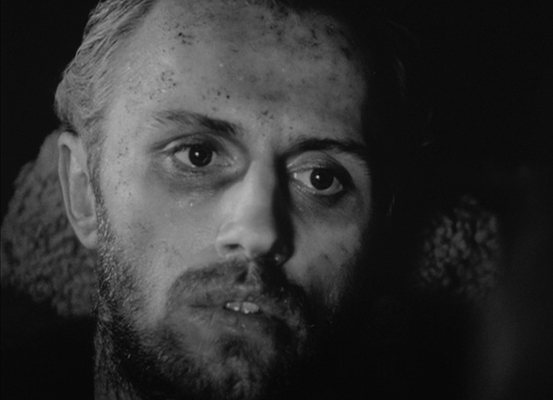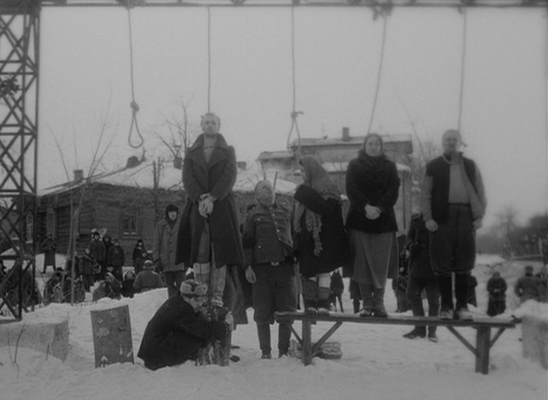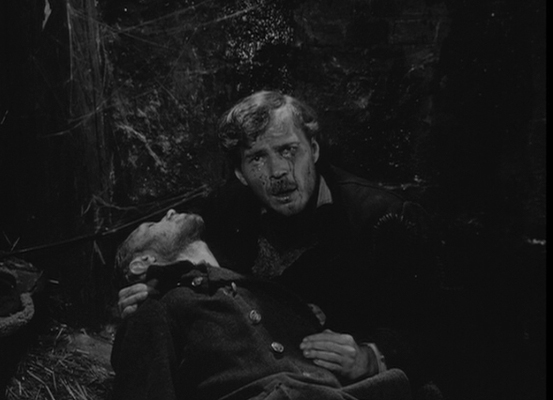In Search of a Final Flight: Two Films by Larisa Shepitko on DVD (Film Review)
WINGS. DIRECTED BY LARISA SHEPITKO, 1966. RELEASED ON DVD BY THE CRITERION COLLECTION, 2008. 85 MIN, 1:33:1 ASPECT RATIO.
THE ASCENT. DIRECTED BY LARISA SHEPITKO, 1977. RELEASED ON DVD BY THE CRITERION COLLECTION, 2008. 109 MIN, 1:33:1 ASPECT RATIO.
The 1965 end of year issue of Sovetskiy Ekran, the leading Soviet film magazine, came with a mail-in questionnaire.(Much of the information on the restructuring of the Soviet Film industry is based on Hill, Steven “Soviet Film Today” in Film Quarterly, Vol. 20, No. 4 (Summer, 1967), pp. 33-52.) Alongside garden-variety marketing research questions about film attendance and favorite films for that year, there were more curious and probing questions such as “in I am Twenty, were you interested in the characters’ meditations about the meaning of life?” After Khruschev’s public condemnation of Marlen Khutsiev’s Antonionesque I am Twenty (1961), it is tempting to read such a question as another signal that the “thaw” would be followed by a freeze-up. This is not quite the whole story.
More than anything, the SE questionnaire, along with a series of similar audience research initiatives, speaks to the significant rebuilding and restructuring of the Soviet film industry that began as part of the Khruschev thaw in the late 1950’s and affected Soviet film production during much of the 1960’s. Spearheaded by Grigori Chukhrai (along with other members of the so-called “first Soviet new wave”) who became the leader of an economic reform movement, the many new initiatives included: standardized script formats, increased exhibition foreign titles, retrospectives of older films, introduction of greater efficiency standards in production, reorganization of VGIK, establishment of Chukhrai’s Experimental Studio (ETK – ????????????????? ?????????? ?????????? ??? ?????????).
Along with significant changes in film production, greater focus on the economics of film distribution and exhibition initiated a transition from a monolithic view of Soviet film audiences towards recognition of viewers as consumers with different tastes. On the pages of the Soviet film press a “rehabilitation of genres” was taking place and detective adventure films, science fiction spectacles, and slapstick comedies began to be produced. Most importantly, something like auteurist approach to filmmaking became a fleeting yet real possibility.
The DVD release of Larisa Shepitko’s two best films, 1966’s Wings (??????) and 1977’s Ascent (???????????) fills an important, albeit brief, chapter in the history of post-war cinema in the Soviet Union. Generally speaking, post-war Soviet filmmakers can be divided into two generations: those born in the 1920’s who lived through the war as young adults and went on to make films about war as a social and historical reality (Chukhrai’s Ballad of a Soldier (??????? ? ???????, 1959); Kalatozov’s Cranes are Flying (????? ???????, 1957), and a later generation made up mostly of the children of war.
This latter group would make their childhood phantasmagoria speak to the trauma of war as well as to war’s reverberations in the peace that followed. Shepitko’s films fall into this category, along with Tarkovsky’s Ivan’s Childhood (??????? ???????, 1962); German’s 20 Days Without War (20 ???? ??? ?????, 1976), and Elem Klimov’s Come and See (??? ? ??????, 1985). It is a telling fact that in Germany the rethinking of Nazism and its legacy would similarly come from a new generation of filmmakers (Fassbinder, Kluge, Schloendorff), all of them roughly the same age as Russia’s children-of-war directors.
Born in 1938, Larisa Shepitko began her study of film in 1955 under the tutelage of Alexander Dovzhenko and, after Dovzhenko’s death in 1956, continued her studies with Mikhail Chiuareli. Though Shepitko’s own career was tragically brief, cut short by an automobile accident shortly after her 40th birthday, her films remain important landmarks in Soviet cinema.
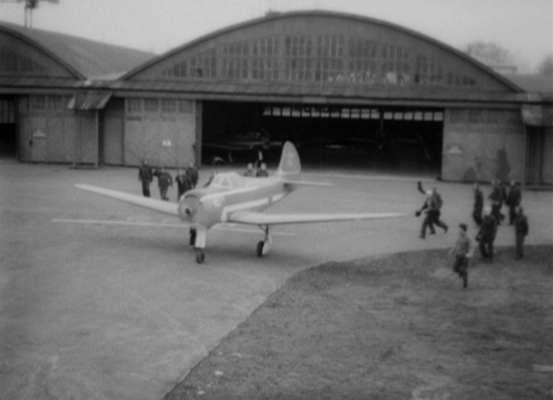 Larisa Shepitko never shied away from admitting that her films, though never strictly autobiographical, presented explorations of her own psychology. She looked for stories written in an objective manner; stories that left enough room to accommodate the psychological nuances that are the lifeblood of Shepitko’s films. In Wings, a simple story about a former female pilot evolves into a graceful meditation on the inability of past ideals to sustain and nourish indefinitely. Petrukhina (Maya Bulgakova) is a war pilot turned school headmistress, a civil leader and an outstanding member of her community. She is a protagonist of a socialist realist film who finds herself in a different era, a displaced hero of her time.
Larisa Shepitko never shied away from admitting that her films, though never strictly autobiographical, presented explorations of her own psychology. She looked for stories written in an objective manner; stories that left enough room to accommodate the psychological nuances that are the lifeblood of Shepitko’s films. In Wings, a simple story about a former female pilot evolves into a graceful meditation on the inability of past ideals to sustain and nourish indefinitely. Petrukhina (Maya Bulgakova) is a war pilot turned school headmistress, a civil leader and an outstanding member of her community. She is a protagonist of a socialist realist film who finds herself in a different era, a displaced hero of her time.
In the opening scenes, there is little wistfulness or vulnerability in Petrukhina. Cold and categorical, she is largely an unsympathetic character. When she expels a mischievous student, she does so with an inhumane precision that borders on cruelty. Her moral rectitude is severe enough as to feel inappropriate to her surroundings. Refusing to show Petrukhina as nostalgic or sentimental at the outset is a masterful stroke on Shepitko’s part. Rather than humanize her in a familiar way, the film patiently follows Petrukhina’s growing disconnect from her own righteousness. It is only by going through this gradual and humbling process that Petrukhina is redeemed in the eyes of the viewer.
In an interview Shepitko described Wings as a film about the aftermath of victory, about civilian life for a war generation. Petrukhina’s journey in the film is one of existential reorientation as “she lives in concord with her conscience but the times put new criteria in front of her…The war has put its stamp on her thinking. Everything in wartime is brutal, definite and clear—an enemy is an enemy, a coward is a coward. She had carried these theoretical judgments over into civilian life and failed to realize that her swift decisions had turned into superficial decisions.”(Shepitko, Larisa cited in World Film Directors V II. Ed. John Wakeman. H.H.Wilson Co. NY 1988.)
Equipped with the tools and morals of heroic realism, Petrukhina finds herself adrift in an art cinema narrative,moving from place to place, from one alienating encounter to the next, an effect in search of its cause. As Petrukhina delves into her past with increasing frequency, the film follows suit by shifting into a lyrical, impressionistic mode. The result is a curious exercise in estrangement where life’s sensation is restored, slowly, almost imperceptibly.
Though a superb character study, Wings is stylistically uncertain. The shifts between extreme subjectivity (a flashback sequence shot entirely as optical point-of-view) and an objective detachment (extraneous camera movements and several unfortunate zooms) are uneven and distract from the kind of character commitment the story demands. From its opening shots, The Ascent, Shepitko’s last and finest film, reveals a directorial confidence and command absent in Wings. Like the earlier film, with its reliance on the stock character of a civil leader, The Ascent sets out using familiar themes of loyalty and betrayal in times of war. At the film’s outset two soldiers, Sotnikov and Rybak, leave their platoon on a mission to get provisions. A hierarchy between the two becomes apparent early on. When the sickly Sotnikov is wounded, Rybak crawls through the snow, risking his life to save Sotnikov from German bullets. As with Petrukhina’s righteous headmistress, Shepitko shows Rybak as a familiar heroic type, an amalgam of courage, loyalty, and perseverance.
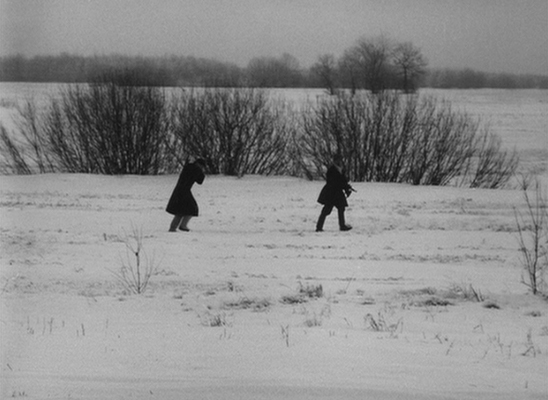 Shot on location in snow-covered Belarus and gorgeously photographed with some impressive handheld work, the film’s visual lyricism suggests a religious parable from the start, as Rybak and Sotnikov are shown in extreme long shot, moving across an endless expanse of white. Their dialogue is largely inconsequential and mostly works as a counterpoint to bursts of wind and the sound of snow crunching underfoot. The film’s magnificent score, written by Alfred Schnittke, builds on these atmospheric sounds. For most of the film, Schnittke does not use traditional harmonies, but relies on a series of tone clusters to create a droning soundscape that builds in intensity along with the story.
Shot on location in snow-covered Belarus and gorgeously photographed with some impressive handheld work, the film’s visual lyricism suggests a religious parable from the start, as Rybak and Sotnikov are shown in extreme long shot, moving across an endless expanse of white. Their dialogue is largely inconsequential and mostly works as a counterpoint to bursts of wind and the sound of snow crunching underfoot. The film’s magnificent score, written by Alfred Schnittke, builds on these atmospheric sounds. For most of the film, Schnittke does not use traditional harmonies, but relies on a series of tone clusters to create a droning soundscape that builds in intensity along with the story.
In its efficiency, style and thinly veiled religious allegory, The Ascent recalls Dovzhenko’s early masterpieces as well as Robert Bresson’s Au Hazard Balthazar (like Bresson, Shepitko cast two unknowns for the leads). Yet the most pronounced influence on the film seems to be that of Fyodor Dostoyevsky. Shepitko wrote the script during several months spent in the hospital, recovering from a life-threatening illness. The period was to be both a time of reflection on personal mortality and a productive period during which Shepitko would complete two scripts, the first, based on Dostoyevsky’s novella The Village of Stepanchikovo, and the second on Vasilli Bykov’s novel Sotnikov. The synthesis of this dark period in Shepitko’s life manifests itself as the central question that Sotnikov and Rybak face in The Ascent: can the act of one’s death bestow a kind of immortality?
“For what?” Portnov, a former Soviet organizer turned Nazi interrogator, asks Sotnikov, “to set an example for future generations? But you won’t have a heroic death. You won’t just die, we’ll have you die a traitor’s death. If you won’t tell, someone else will. And we’ll blame it on you anyway.” Despite knowing that he’ll be remembered as a traitor, Sotnikov chooses torture and death. The scene that follows the interrogation is one of truly Dostoyevskian proportions. Using blocking and framing based on depictions of Jesus in European art (including Hans Holbein’s Christ featured prominently in The Idiot), the scene is of five people in a dark cellar awaiting execution. As they gather around Sotnikov’s brightly lit face, the characters struggle to come to terms with the immediacy of their own deaths. For Sotnikov, the fact of bearing moral witness reconciles him with the death that awaits him: “We will remember! We will remember in our graves!”
Sotnikov’s ability to say these words – words Rybak takes to be meaningless – creates the film’s central conflict. The heroic Rybak turns into a traitor because his heroism is inseparable from his will to survive. Rybak survives because he cannot imagine an alternative and because he cannot fathom sacrifice for the sake of a principle rather than a material end. As Rybak puts it in the film: “my conscience is busy thinking of a way out!” This reversal, one that turns a heroic character into a traitor, succeeds so splendidly because it shows Rybak’s struggle and failure to find a new set of moral norms. Like Petrukhina in Wings, Rybak is not immoral. And like her, Rybak is limited by the principles of a lionhearted Soviet soldier who perseveres against all odds. Rybak’s is a moral code that does not admit immortality; this is his tragedy and not his villainy.
Rybak’s tragedy and its source is a crucial point that is easily lost in the heavy religious symbolism of the film. Sotnikov may be a martyr, but Rybak is not Judas. The ability to move past the familiar sense of betrayal speaks to the psychological depth that Shepitko’s film is able to reach with her characters. Writing in the New Yorker in 2002, Susan Sontag put it thus: “No photograph, or portfolio of photographs, can unfold, go further and further still, as does The Ascent …the most affecting film about the horror of war I know.”(Sontag, Susan “Looking at War” in The New Yorker December 9, 2002.) Though Larisa Shepitko’s career was brief, the films she made represent a generation of filmmakers who went “further and further still” beyond the immediate enormity of actual war. In their films, Shepitko, along with the other children-of-war directors, transcended the limits of historical realism and verisimilitude to show war as a persisting condition rather than an event, as a past that always moves beyond its confines.


